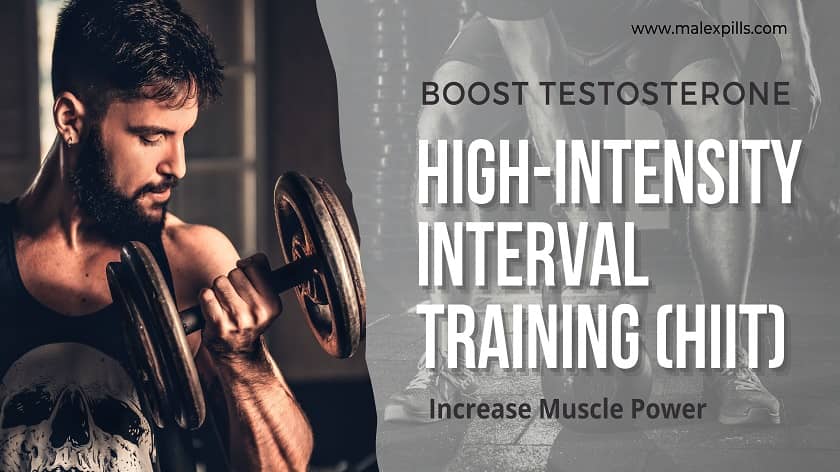HIIT And Testosterone
High-Intensity Interval Training (HIIT) is a type of workout that alternates between high-intensity exercises and periods of rest.
HIIT sessions are usually shorter in duration (10-30 minutes) compared to traditional workouts, but they are intense and can help you burn more calories, improve cardiovascular health, and increase strength and endurance.
HIIT workouts can be done using various types of exercise, such as running, jumping jacks, squats, and burpees.
It’s important to start with a proper warm-up and end with a cool-down and stretching.
HIIT can be challenging, but it can also provide great results if done regularly and properly.
HIIT And Testosterone: What’s The Connection?
High-Intensity Interval Training (HIIT) has been linked to increased testosterone levels in some studies.
Testosterone is a male hormone that plays a crucial role in muscle growth and repair, as well as overall health and well-being.
During HIIT, the body experiences a significant increase in heart rate and oxygen consumption, which stimulates the release of testosterone.
This release is thought to help increase muscle growth and improve overall athletic performance.
However, it’s important to note that not all studies have shown a significant link between HIIT and increased testosterone levels, and the results can vary depending on several factors such as age, fitness level, and type of HIIT workout.
Additionally, the effects of HIIT on testosterone levels may be short-lived, with testosterone levels returning to normal soon after the workout.
It’s also important to consider that there are many other factors that can affect testosterone levels, such as diet, sleep, and stress levels.
Maintaining a healthy diet that is rich in protein, healthy fats, and micronutrients, as well as getting enough rest and managing stress, can help support healthy testosterone levels.
In conclusion, while there is some evidence that suggests that HIIT can increase testosterone levels, more research is needed to fully understand the link and its effects.
If you are looking to improve your testosterone levels, it’s important to consider a well-rounded approach that includes a healthy diet, adequate sleep, and stress management in addition to regular exercise.
Does HIIT Training Increase Testosterone?
High-Intensity Interval Training (HIIT) has been shown to potentially increase testosterone levels in some studies.
Testosterone is a hormone that plays a crucial role in muscle growth, strength, and overall health and well-being.
During a HIIT workout, the body experiences a significant increase in heart rate and oxygen consumption, which can stimulate the release of testosterone.
This increase in testosterone may help to improve athletic performance and increase muscle growth.
However, it’s important to note that the results of studies linking HIIT and testosterone are not consistent, and the effects may vary depending on several factors such as age, fitness level, and type of HIIT workout.
Some studies have shown little to no effect of HIIT on testosterone levels, while others have shown a temporary increase.
In conclusion, while HIIT may have the potential to boost testosterone levels, more research is needed to fully understand the link and its effects.
It’s also important to keep in mind that testosterone levels are influenced by many factors such as diet, sleep, and stress, so a well-rounded approach to overall health and wellness is important for maintaining healthy testosterone levels.
How Does HIIT Increase Testosterone Production?
High-Intensity Interval Training (HIIT) has been shown to potentially increase testosterone levels in the body through the stress it places on the body during the workout.
During HIIT, the body experiences a significant increase in heart rate and oxygen consumption, which can stimulate the release of various hormones, including testosterone.
The intense physical stress of HIIT may also increase the production of luteinizing hormone (LH), which acts as a trigger for the release of testosterone from the testes.
Testosterone is a hormone that plays a crucial role in muscle growth, strength, and overall health and well-being.
Higher testosterone levels can help improve athletic performance and increase muscle mass, which can lead to improved body composition.
How Much Does HIIT Increase Testosterone?
HIIT (High-Intensity Interval Training) has been shown to increase testosterone levels in men, although the exact amount of increase can vary based on factors such as age, fitness level, and diet.
On average, studies have found that HIIT can increase testosterone levels by up to 20-30%.
It’s important to note that the effects of HIIT on testosterone levels can vary depending on several factors such as age, fitness level, and type of HIIT workout.
Additionally, while some studies have shown an increase in testosterone levels after a HIIT workout, the effects may be short-lived, with testosterone levels returning to normal soon after the workout.
In conclusion, HIIT has the potential to increase testosterone levels in the body by placing physical stress on the body during the workout and potentially triggering the release of testosterone and LH.
7 Best HIIT Workout For Testosterone
Here’s a list of the best HIIT workouts to increase testosterone in men.
Take a look…
Burpees
Burpees are a full-body exercise that can help increase testosterone levels.
To perform a burpee, start in a standing position, then squat down and place your hands on the floor.
Kick your feet back into a push-up position, then quickly return to a squat and jump up. Repeat for 10-15 reps.
Sprints
Sprints are a great way to increase heart rate and stimulate the release of testosterone.
Sprint for 30 seconds at full speed, then rest for 1 minute. Repeat for 5-10 sets.
Jump Squats
Jump squats are high-intensity exercises that can help increase testosterone levels.
Start in a squat position, then explode upward into a jump.
Land softly and immediately return to the squat work. Repeat for 10-15 reps.
Box Jumps
Box jumps are a plyometric exercise that can increase testosterone levels.
Stand in front of a box or platform, then jump onto the box with both feet.
Step or jump down, and repeat for 10-15 reps.
Kettlebell Swings
Kettlebell swings are a full-body exercise that can help increase testosterone levels.
Start with a kettlebell between your feet, then swing it up to chest height, using your hips and legs. Repeat for 10-15 reps.
Medicine Ball Slams
Medicine ball slams are a high-intensity exercise that can help increase testosterone levels.
Hold a medicine ball overhead, then slam it down onto the ground as hard as you can. Repeat for 10-15 reps.
Battle Ropes
Battle ropes are a full-body exercise that can help increase testosterone levels.
Stand with your feet shoulder-width apart and hold the ropes in each hand.
Alternately wave the ropes up and down for 30 seconds, then rest for 1 minute. Repeat for 5-10 sets.
The Bottom Line
It’s important to note that HIIT workouts are intense and can be challenging, so it’s essential to start with a proper warm-up and end with a cool-down and stretching.
Additionally, while HIIT workouts have the potential to increase testosterone levels, they are just one aspect of a well-rounded approach to overall health and wellness.
You can combine workouts with a healthy diet and adequate rest and stress management.



